INTRODUCTION:
You don’t need to browse social media or a technical forum for very long to find a thread about “which gear (and converter – for the automatic crowd) should I run in my car”. These discussions are usually plagued by a lack of key information about the car in question – which transmission it has, the motor combination, the vehicle weight, and how it’s used, along with a string of replies with varying amounts of truth and misinformation that leave the original asker even more confused. In Part One of this series, we’re going to help the stick shift guys with the final drive ratio – determined by the ring and pinion ratio of the rear differential. In Part Two we’ll take a look at final drive choices for automatic combinations, and discuss the torque converter and the critical role it plays in making those cars so good at that critical first sixty feet of the dragstrip.
Gears are basically a series of circular levers that mesh together to provide constant transmission of rotary power. When you pair a smaller drive (input) gear with a larger driven (output) gear you trade RPM for torque on the driven gear. If the drive gear is half the diameter of the driven gear, the driven gear will produce half the RPM, but twice the torque of the drive gear. When we increase the final drive ratio in a car we are trading rpm for torque, which translates into stronger acceleration. This tech article aims to help you making a gear choice for your 5th Gen Camaro SS, G8, Caprice, SS, or C5/6/7 Corvette.
“But wait – what about my 5th gen ZL1, CTS-V, or 6th gen Camaro?” Well, it’s simple, you don’t get a choice. Manual transmission cars all have a 3.73:1 ratio, six speed automatic cars have a 3.23:1 ratio, and eight/ten speed automatic cars have a 2.77:1 ratio. There are no aftermarket options to change those ratios. Automatic cars could consider a gear change to the OEM M6 rear end, but the power of the LSA or LT4 combine with the aggressive 1st gear ratios in their respective transmissions reduces usable street traction in 1st gear too so little as to negate any value of the change. The good news is that the automatic cars are geared very well from the factory. Manual guys could definitely benefit from some options, but we’re unlikely to see anything for the OEM differential emerge on the market at this point.
Before we get technical and nerdy I’ll give you guys that want to skip the journey the final answer. From a street/strip perspective a naturally aspirated M6 car will perform best with 4.10s, and A6 cars will perform best with 3.91s. If you’ve got boost or nitrous, then the answer really is – it depends. Want to learn why? Read on!
THE BASICS AND RELEVANT LATE-MODEL GM MANUAL TRANSMISSIONS:
Let’s start by defining a few terms and transmission models you’ll see all over the internet, and throughout this article. “M6” refers to a manual transmission, with six forward gears. “A8” would designate an automatic transmission with eight forward gears. We’re going to deal with two transmissions in our series:
To throw one more wrench in the gearbox there are several different models, with varying gear ratios, within the TR6060 side of the house. Most notable is the M10 variant found in Camaro SS, and the often misunderstood MM6 variant found in the ’13-’15 Camaro SS 1LE. Many a 1LE owner has falsely laid claim that the 1LE has an acceleration advantage because it has the 3.91:1 final drive ratio, where-as the regular SS models have a 3.45:1 final drive ratio. What they fail to realize is that the 1LE has lower gear ratios within the MM6 transmission itself. GM equipped the 1LE with the MM6 transmission and 3.91 final drive ratio specifically to better position 4th gear between 3rd and 5th gears, as the M10 TR6060’s have a large shift rpm drop on the 3-4 shift, and a very small shift rpm drop on the 4-5 shift. GM has their reasons for this approach on M10 equipped cars (mostly rooted in fuel economy), but the practical outcome is that other than when in 4th gear, a regular SS and a 1LE are geared almost exactly the same. When you pair a regular SS with a 3.91, or better yet a 4.10 final drive gear ratio, the M10 equipped SS has a decisive advantage off the line. See Fig.1 and Fig.2 for a comparison.
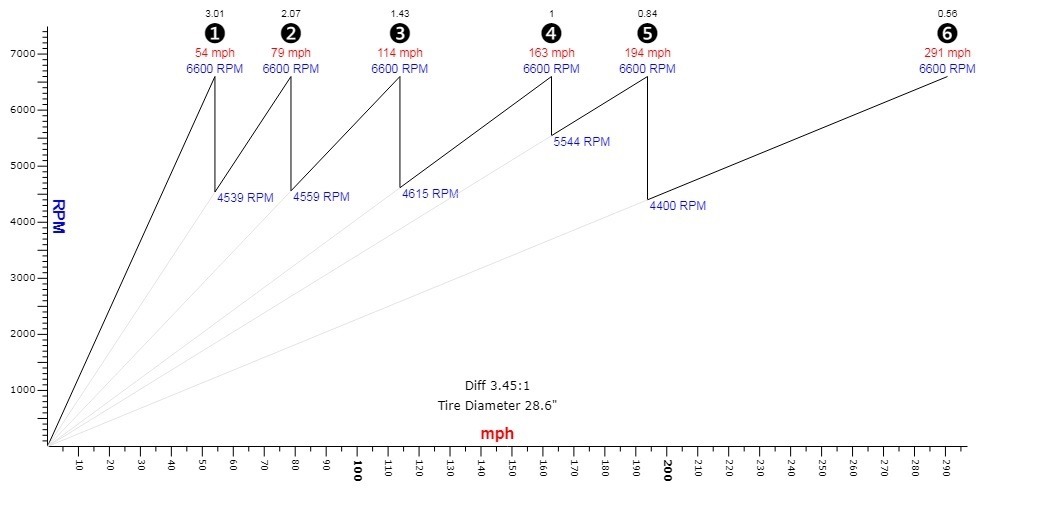

CHOOSING THE RIGHT FINAL DRIVE RATIO FOR YOUR COMBINATION:
Our context for the series is selecting gear ratios for quarter-mile drag racing, but the approach here can be applied to other forms of racing (e.g half-mile, circuit, etc). For drag racing, we want to give the car the most aggressive gear ratio we can to maximize torque to the wheels from the power the engine produces throughout the quarter-mile. There are two major considerations in our choice:
- Improving initial acceleration with a stronger multiplication of torque in 1st gear
- matching our trap speed RPM to our engine combination. We want to use three gear shifts, using as much of 4th gear as is practical, but avoiding a 4-5 upshift.
It is possible to gear the car with less final drive ratio to allow for completing a quarter-mile with only 3rd gear, but this results in a very “long” first gear which makes achieving a good launch extremely difficult, is harder on the clutch, and produces a lower overall average RPM for the duration of the run, which will translate to lower average power.
To determine the best gear ratio for the car we need some insight into what to expect for trap speed. There are many calculators on the internet that will produce a variety of results. For our example today we’ll consider a TR6060 M10 equipped heads/cam/bolt-on 5th gen Camaro making 500whp at 6500pm, running a stock height tire. Our example car will produce a trap speed of around 121mph at full weight. You can easily add or subtract several miles per hour from that depending on the huge number of factors that influence quarter mile performance (air quality, wind speed, track surface conditions, 60’ time, driver ability, etc). Our imaginary “build” has substantially altered the power curve from stock, elevating it 500+rpm, and will certainly benefit from a gear change.
First, let’s consider the stock final drive ratio. This car would cross the line at 4900rpm with the stock 3.45 gears at 121mph. This is far from ideal as we are quite far from the engines peak power, barely getting into 4th gear before crossing the line. Also, we have a car with a long first gear that’s difficult to launch without either bogging the engine, or spinning the tires. If we upgraded to a 3.91 gear that would raise our rpm to 5500rpm at 121mph and give us 13% more torque off the line and through each gear. That improves our acceleration with the mechanical advantage, and makes the car easier to launch without bogging. It also helps by keeping our average RPM throughout the run up higher, closer to where the engine develops peak power.
If we went with 4.10 gears would see the rpms increase to 5900rpm at 121mph, and a 19% increase in torque off the line and through the gears. This improves on the 3.91 change, adding even more mechanical advantage. Heavy stick shift cars require lots of RPM and clutch slip and/or some calculated wheel-spin to keep the engine from bogging. The higher final drive ratio helps the car come up to speed quicker in those first 60 feet with the increased torque output. The 3.45 to 4.10 change in our example car could easily be worth four tenths of ET and four MPH of trap speed with the 60’ time improvement we can expect, along with the increased average hp throughout the run.
You may have noted that we didn’t make it to the 6500peak power rpm with the 4.10 gear ratio. Ideally, we would run a few hundred RPM beyond the peak to make for the highest average power in a pass. There are no sources for more than a 4.10 final drive ratio gear in our application. However, there is another card we can play – tire size. You’ll find that the fastest all motor stick shift 5th gen Camaro guys pretty much all have one thing in common, and that’s a set of short, 26” tires. The shorter tire does give up some advantages in launching to a tire with more sidewall, and seems to defy conventional stick shift wisdom to run a soft, tall sidewall tire to best absorb shock at the launch. The shorter tires have the same influence as a higher final drive ratio, it increases the rpm at a given speed. A Hoosier DR2 in a 275/40/17 actually measures at 25.7”, and would raise the rpm at the traps in our examples above all the way to 6500rpm at 121mph. This extra RPM, combined with the additional help of the increased torque at launch, more than makes up for the decreased sidewall, making the short tire a very great option to squeeze out that last 1-2 tenths of ET. The author’s personal 5th gen Camaro gained a repeatable 2.5mph increase in trap speed when changing from 28” to 26” tires.
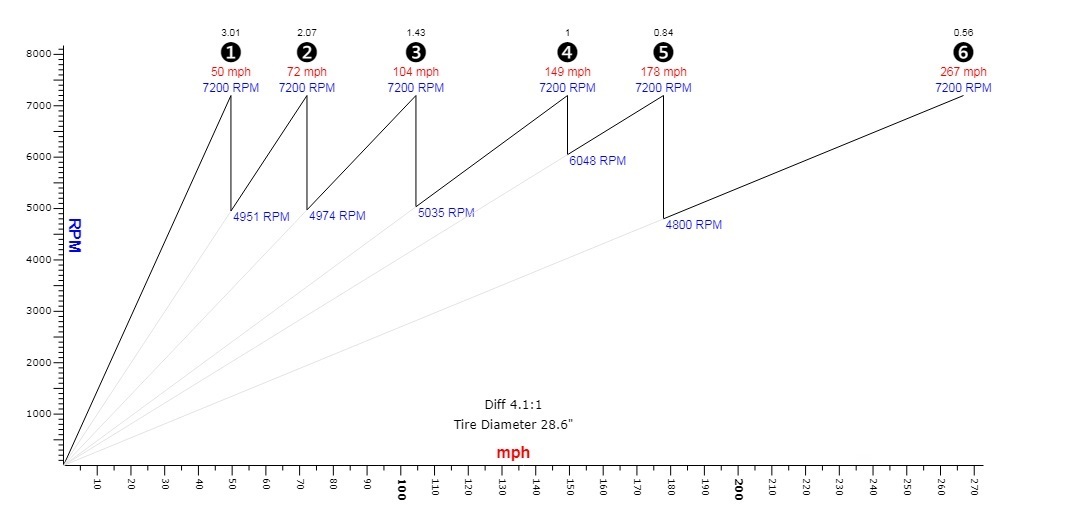
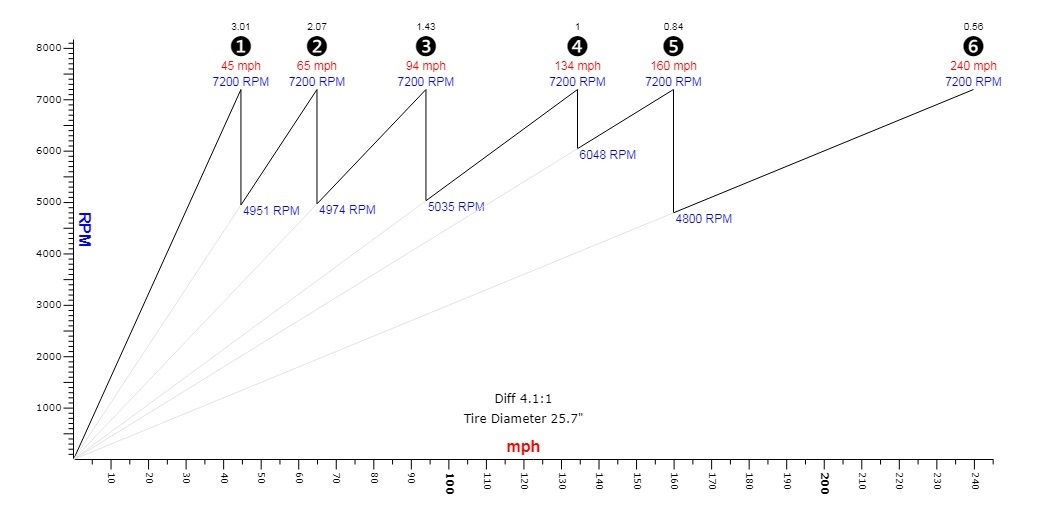
OTHER CONSIDERATIONS:
Of course there are many other scenarios beyond the examples laid out above that will influence your gearing choice. A power adder can dramatically alter the low end torque output to the point where you could over-gear a car and create traction issues. There are also practical considerations about the overall strength of the driveline. Our example car’s 218mm/8.6” rear differential unit does not have a good reputation for strength, especially when paired with the violence of a stick shift car. The entire rear driveline (axles, differential housing, ring and pinion) is undersized and understrength for the weight and power of the 5th Gen Camaro. Aggressive launching on sticky tires at almost any power level can eventually lead to damage to any of the driveline parts. Excessive shock loads from wheel-hop, clutch dumps, and no lift shifts can all contribute to dramatically shortening the life of the those driveline parts – with axle failure and ring and pinion failure being the two most commonly damaged components. Upgraded axles as well as well as upgraded differential parts (Eaton TruTrac, PCE Differential cover) are available and improve, but not eliminate this potential for breakage. At times a change to the much larger, heavier and stronger ZL1 differential and axles is made in favor of strength, even at the expensive of running a less than ideal 3.73:1 gear ratio. Aftermarket rear end solutions also exist, but can be quite an expensive venture.
On the fuel economy front consider a TR6060 equipped car with 4.10s is turning just over 2,000rpm at 75mph. This does have the effective of diminishing fuel economy slightly. Fortunately, the TR6060’s double overdrive is extremely generous, allowing for aggressive rear gear ratios to be run without a significant cruising RPM penalty.
Top speed is always an area of heated debate and discussion when it comes to gearing changes. Back in the muscle car days of the 60’s and 70’s going to a higher gear ratio in the rear end was a real question of sacrificing top speed – as the highest transmission gear ratio was 1:1. Going to 4.10’s posed a significant limitation on your top speed – especially to the cars of that age which had shorter tires and much lower redlines. Fast forward to the present and you’ll find the top speed question to be a non-issue. In our example above (fig. 3), a car with 4.10s, the M10 TR6060 variant, and OEM 28” tires can pull almost 180mph in 5th gear. For an all motor car you’re approaching the power to aero drag limits at that point. You’re also well into the practical limit of “how fast do you really need to be able to go”?
Lastly, let’s not forget drive-ability. Stick shift cars in particular do not have the benefit of a torque converter to dampen low-rpm stumbles, kicks, and jerks associated with a big, high overlap aftermarket camshaft. A gear change will increase the rpm at parking lot speeds in 1st gear, as well as give a higher cruising rpm – in both instances improving the feel of the car, lifting the rpms up above the range most impacted by the cam change. This often overlooked factor can make a tremendous difference in the relative driving comfort of a large cam, stick shift car.
CONCLUSION:
As you can see, there are many factors that influence your choice in a final drive ratio change for your stick shift car. These changes have a profound impact on feel and performance and are one of the best modifications you can do to improve the performance and drive-ability of your ride. If you’re still not sure about what’s right for you, feel free to reach me at [email protected] – we’ll get you sorted in no time!
Stay tuned for our sequel to this article – rear gear ratio and converter choices for the automatic guys. We gave the stick cars the jump here, but we’ll be back with Part Two with help for auto guys to get caught up.

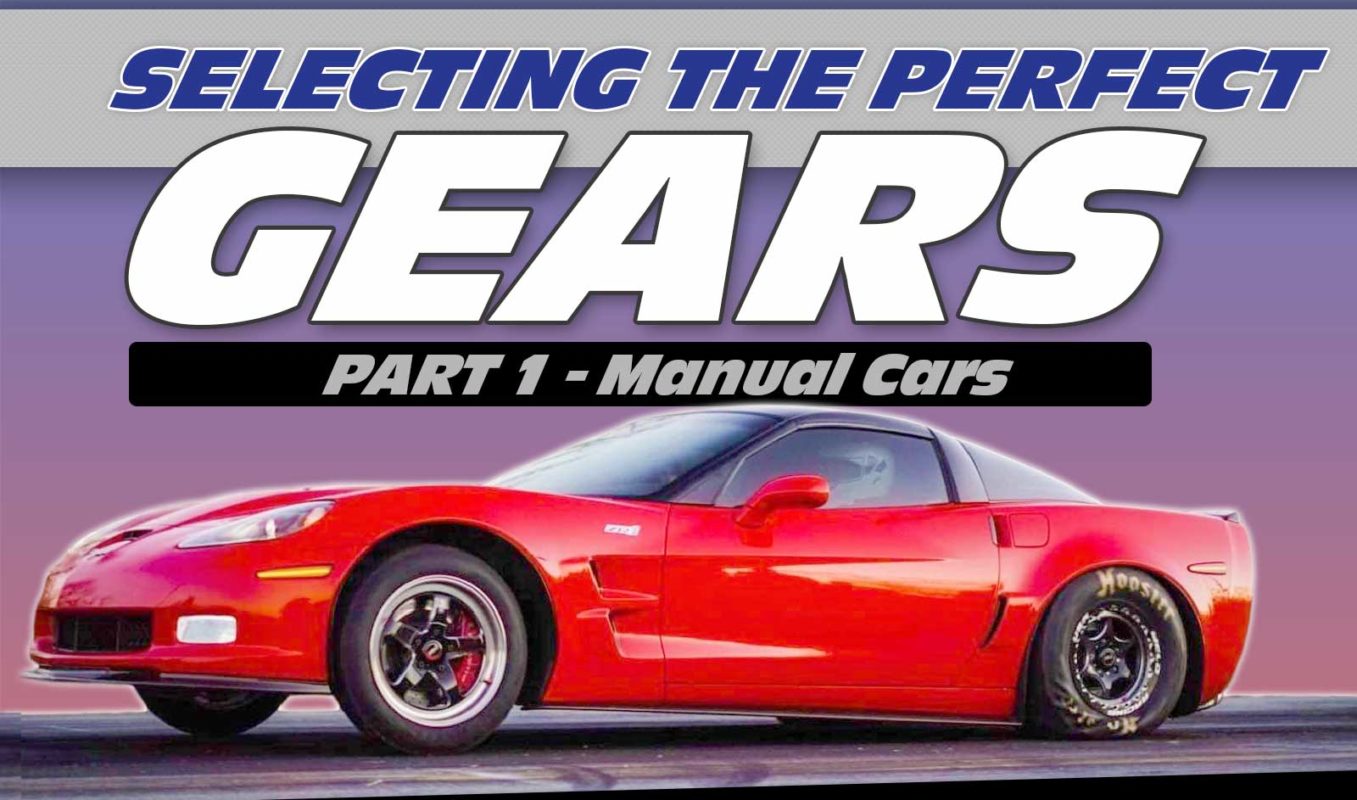
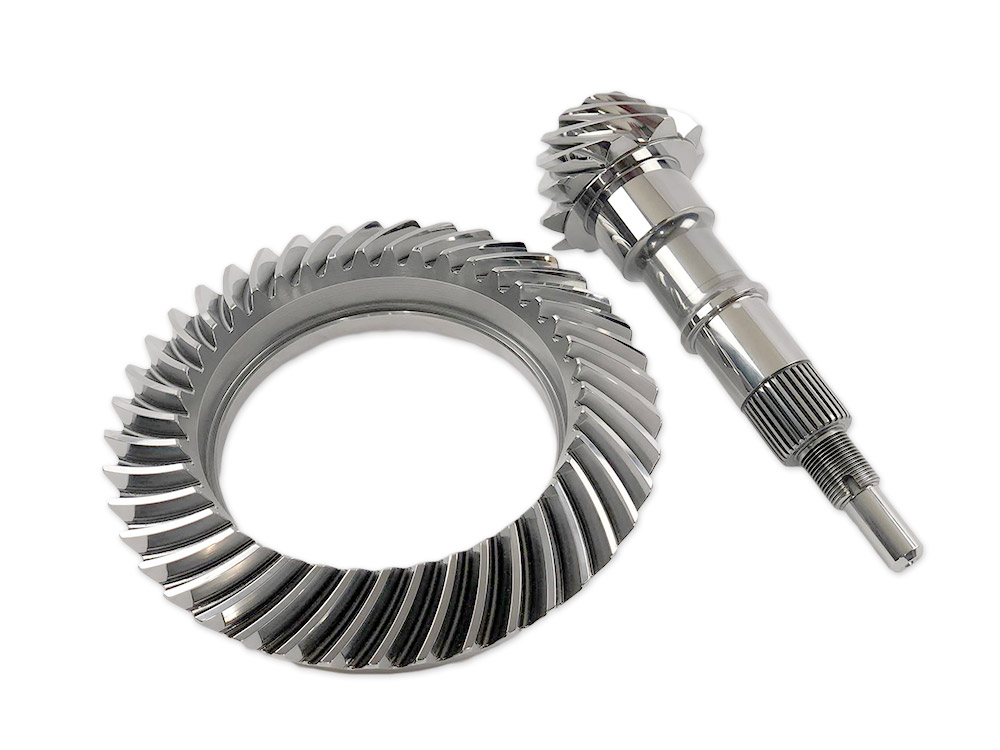
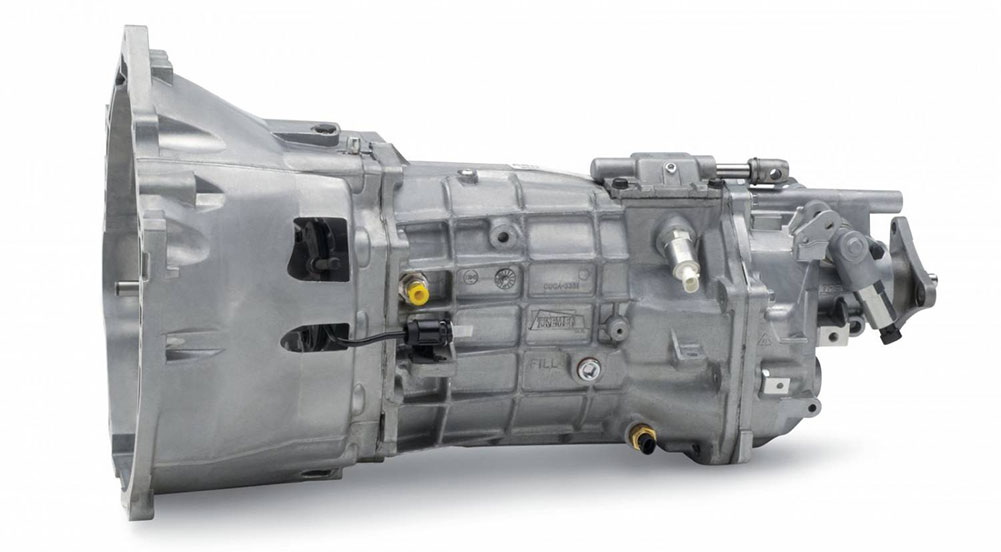
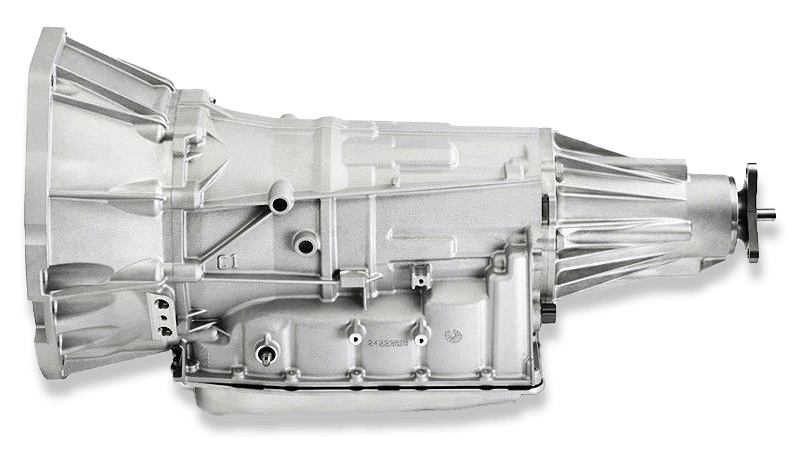

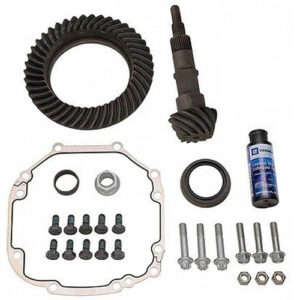
This was like a breath of fresh air! You get it, finally someone gets it. There is so much misinformation and misunderstanding out there on this topic. Loved this article, keep this stuff going!
Great job!
Thank you,
Great article! Looking foreword to more. Building an LT1 powered manual 67 Chevelle for the strip.